
|

|
|
Home Site Search Contact Us Subscribe
|
|
From Warehouse to Wired Green Workspace The Alliance Center in Denver, designed by Gensler for the Alliance for Sustainable Colorado, offers a model for how aging buildings can be transformed into thriving, sustainability-focused, collaborative workspaces. By Ashley Lovell, Ph.D. January 25, 2018 Buildings account for 39% of greenhouse gas emissions in the U.S., more than either the transportation or industrial sectors. Furthermore, over the next 25 years, CO2 emissions from buildings are projected to grow faster than any other sector, with emissions from commercial buildings projected to grow the fastest – 1.8% a year through 2030. Renovations of energy-hungry warehouses have the potential to dramatically reduce greenhouse gas emissions while providing innovative collaborative workspaces.
The Alliance Center, a project of the Alliance for Sustainable Colorado, offers a model for how aging buildings around the country can be transformed into thriving, sustainability-focused collaborative workspaces. What instigated this transformation? A desire to create and maintain the physical and social drivers of inspiration in the workplace.
The Alliance Center is a six-story, 40,000-square-foot collaborative workspace located at the heart of lower downtown Denver. Originally built in 1908 as a warehouse, the building that now houses The Center went through a series of renovations to turn it into an office space. In 2004, the building underwent a major energy efficiency and high-performance systems renovation. These improvements earned the building two U.S. Green Building Council LEED (Leadership in Energy and Environmental Design) certifications – Existing Buildings Gold and Commercial Interiors Silver – and halved the building’s energy bill. Despite the LEED certificates, however, the end result of the design was summarized as “uninviting.” The workspace maintained an atmosphere that was relatively dark, with poor air and traffic circulation, and low ceilings that contributed to a general consensus that the building lacked inspiration.
To address the problem of inspiration, The Alliance Center renovated the building once more in 2014. The design of the space shifted to focus on elevating the human element as the driving force, i.e. advancing productivity through collaboration. As such, the metrics for success also changed from “per square foot” to “per capita” metrics. This was a significant change in direction from the previous design efforts – shifting from attaining LEED certification to promoting productivity, innovation, and wellbeing among the tenants of the building.
The Alliance Center team selected the architectural firm Gensler, in part due to its proprietary Workplace Performance Index (WPI), founded on normative surveys of more than 20,000 respondents, which provides quantification metrics applied to workspace productivity and tenant well-being. The WPI became a significant tool for engagement with the tenants, and was used to get a sense of their well-being. Some of the key hot-button issues identified by tenants included:
1. Increase exposure to daylight and create more connections to the outside by maximizing views. 2. Provide appropriate acoustic privacy in designated spaces to facilitate impromptu and scheduled meetings that require privacy. 3. Provide opportunities for learning and spontaneous interactions around every corner and in every circulation space. 4. Create functional outdoor and indoor spaces that incorporate nature and a sense of connection to the outdoors. 5. Provide meeting spaces for the right-sized groups (2-4 person rooms, larger conferences, etc.) 6. Facilitate seamless integration of technology to maximize use and flexibility of space. 7. Embed sustainable practices and tools into The Alliance Center’s daily operations.
The project interweaves tenant input and productivity measures with energy and resource efficiency metrics. The renovation converted the Center into a highly efficient workspace with an Energy Use Intensity (EUI) rating of 37 – nearly 60% lower than the average EUI of 89 for comparable office buildings. The Center also highlights the collaborative workplace approach as a way to foster impact-driven partnerships between non-profit and for-profit organizations.
Collaborative workspaces are quickly gaining popularity in the U.S., but the majority of these co-working models are designed to appeal to freelance and independent workers. At The Alliance Center, the collaborative model focuses instead on bringing together non-profit organizations and for-profit businesses that are aligned with the Center’s mission to create a more sustainable future. To foster collaboration, tenants are encouraged to collaborate through both the composition of physical spaces and through tenant-only programming, such as expertise exchange lunches, free weekly yoga sessions, happy hours, and building-wide coffee breaks.
How does all of this lead to a more sustainable future for Colorado and beyond? Tenants have begun to form collaborative pods around specific sustainability-related topics. For example, tenants including the Natural Resource Defense Council, WalkDenver, Regis University SEED Institute, Streetsblog Denver and ULI Colorado have all moved into a shared pod at The Alliance Center to focus on creating sustainable transportation solutions for Denver and Colorado.
How can other buildings use The Alliance Center as a model to reduce their emissions and promote productive collaboration?
1. Begin by consulting your tenants. They will have strong opinions and ideas about what makes a happy, healthy, and productive workspace – without their input building renovations may leave current and future tenants disappointed. 2. Determine your timeline and budget. If you have a small budget, consider replacing your light bulbs with energy-efficient LED bulbs and creating a hard-to-recycle station in the office. 3. Consult the U.S. Green Building Council’s LEED certification guidelines to find out where you can engage, and build from there. 4. Read The Alliance Center’s full case study of the renovation for more tips and a detailed description of the building’s transformation.
Dr. Ashley Lovell, Ph.D., is the director of marketing and communications for The Alliance Center. |
(click on pictures to enlarge) 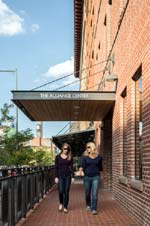 David Lauer Photography The Alliance Center is centrally located in Lower Downtown Denver (LoDo). 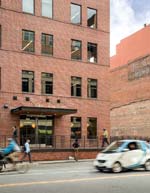 David Lauer Photography The Alliance Center  David Lauer Photography The Alliance Center supports a vibrant tenant community. 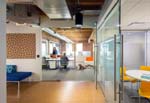 David Lauer Photography A view from a hallway of conference rooms and one of The Alliance Center's office suites 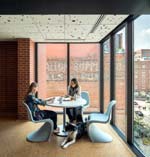 David Lauer Photography One of the many light-filled collaboration spaces 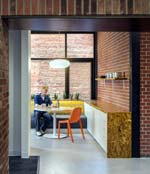 David Lauer Photography Another light-filled collaboration space 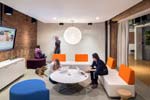 David Lauer Photography One of many conference rooms 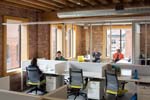 David Lauer Photography An office suite 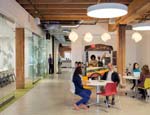 David Lauer Photography The Alliance Center's public café and event space  David Lauer Photography The Alliance Center's public café and event space 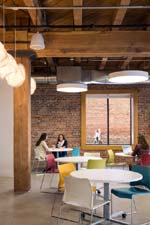 David Lauer Photography The public café 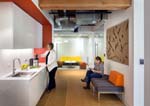 David Lauer Photography There is a mini-kitchen on each floor |
© 2018 ArchNewsNow.com